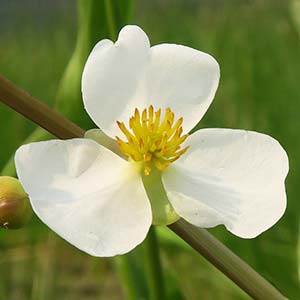Sagittaria latifolia
Alismataceae
bird's-eye pearlwort, broad-leaf arrowhead, common arrowhead, duck-potato, Indian potato, sagittaire latifoliee, wapato
arrowhead family, water-plantain family
septate or not septate.
emersed;
petiole triangular, erect to ascending, 6.5–51 cm;
blade sagittate, rarely hastate, 1.5–30.5 × 2–17 cm, basal lobes equal to or less than remainder of blade.
basal, submersed, floating, or emersed, sessile or petiolate, sheathing proximally;
blade with translucent markings of dots or lines present or absent, basal lobes present or absent;
venation reticulate, primary veins parallel from base of blade to apex, secondary veins reticulate.
racemes, rarely panicles, of 3–9 whorls, emersed, 4.5–28.5 × 4–23 cm;
peduncles 10–59 cm;
bracts connate more than or equal to ¼ total length, elliptic to lanceolate, 3–8 mm, delicate, not papillose; fruiting pedicels spreading, cylindric, 0.5–3.5 cm.
scapose racemes or panicles, rarely umbels, erect, rarely floating or decumbent, whorled (forming racemes) or whorls branching (forming panicles), bracteolate.
to 4 cm diam.;
sepals recurved to spreading, not enclosing flower or fruiting head;
filaments cylindric, longer than anthers, glabrous;
pistillate pedicellate, without ring of sterile stamens.
bisexual or unisexual, if unisexual, staminate and pistillate on same or different plants, hypogynous, subsessile to long-pedicellate;
sepals persistent, 3;
petals deciduous, 3, delicate;
stamens 0, 6, 9, or to 30, distinct;
anthers 2-loculed, dehiscing longitudinally;
pistils 0 or 6–1500 or more, distinct or coherent proximally, 1-loculed;
placentation basal;
ovules1–2.
achenes or follicles.
embryo U-shaped;
endosperm absent in mature seed.
heads 1–1.7 cm diam;
achenes oblanceoloid, without abaxial keel, 2.5–3.5 × to 2 mm, beaked;
faces not tuberculate, wings absent, glands (0–)1(–2);
beak lateral, horizontal, 1–2 mm.
= 22.
Sagittaria latifolia
Alismataceae
Sagittaria latifolia has been divided into numerous species and varieties. It was divided into two varieties, based upon the presence of pubescence over the entire vegetative plant (C. Bogin 1955; K. Rataj 1972). We have examined numerous specimens and found that many from the southeastern United States are pubescent; we believe that this character alone is insufficient for recognition of the varieties.
(Discussion copyrighted by Flora of North America; reprinted with permission.)
Genera 12, species ca. 80 (4 genera, 34 species in the flora).
(Discussion copyrighted by Flora of North America; reprinted with permission.)
1. Pistils weakly coherent proximally into starlike aggregation; petals erose | Damasonium |
1. Pistils distinct, forming heads or rings; petals entire. | → 2 |
2. Pistils arranged in ring around margin of flattened receptacle. | Alisma |
2. Pistils spirally arranged on convex receptacle. | → 3 |
3. Flowers all bisexual; fruits mostly plump, longitudinally ribbed, lateral wings absent. | Echinodorus |
3. Flowers unisexual (at least the proximal); fruits compressed, lateral wing often present, 1, curved. | Sagittaria |
- Local floras:
BC,
CA,
OR,
WA
- Local Web sites:
CalFlora,
CalPhotos,
Flora NW,
Go Botany,
IL Wildflowers,
KS Wildflowers,
LA Plants,
MD Biodiversity,
MI Flora,
MN Wildflowers,
MO Plants,
PNW Herbaria,
Turner Photog.
WildflowerSearch
iNaturalist (observations)
USDA Plants Database
- LBJ Wildflower Center
- SEINet
- Plants of the World Online
- Encyclopedia of Life
- Wikipedia
- Google Image Search
- Local floras:
CA,
OR
- Local Web sites:
CalFlora,
CalPhotos,
Flora NW,
PNW Herbaria
WildflowerSearch
iNaturalist (observations)
- LBJ Wildflower Center
- SEINet
- Plants of the World Online
- Encyclopedia of Life
- Wikipedia
- Google Image Search
